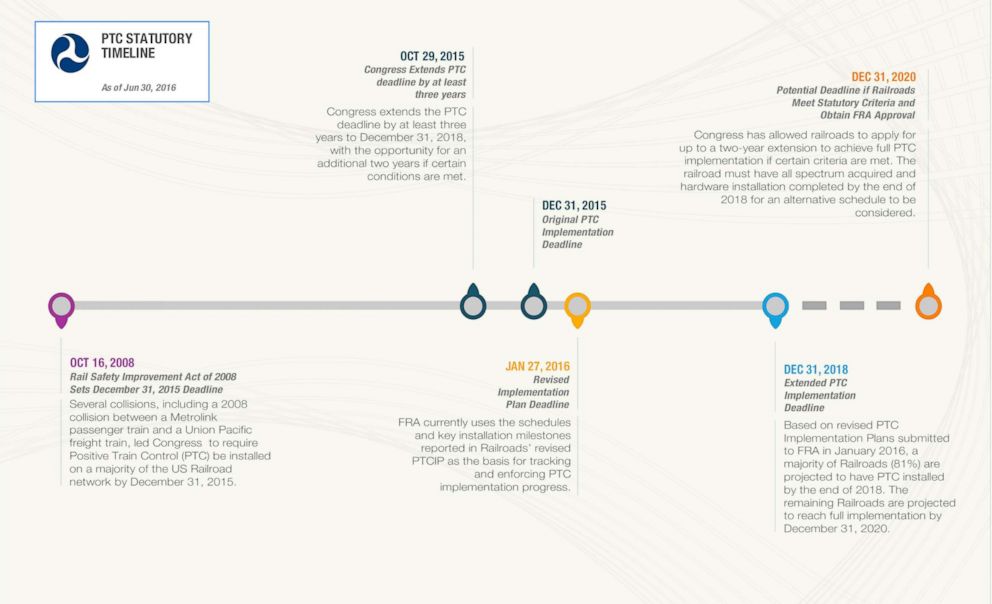Could positive train control have prevented deadly Amtrak crash?
Congress has extended the deadline for the technology twice since 2015.
— -- Even before arriving on the scene of Monday's Amtrak crash south of Seattle, National Transportation Safety Board investigators said they would look at whether a safety technology called positive train control (PTC) could have prevented the crash.
That question became more pressing after federal investigators said late Monday that the train was going approximately 50 mph faster than the speed limit on the section of track where it derailed, killing at least three people and sending more than 90 others to the hospital.
NTSB investigators will spend the next seven to 10 days at the crash site collecting information. Typically the agency's investigators review data for more than a year before meeting publicly in Washington, D.C., to determine why and how a crash occurred.
But news of the excessive speed of the train will without doubt spark speculation long before an official determination of contributing factors and probable causes.
On a call with reporters Monday afternoon, Amtrak President and co-CEO Richard Anderson said PTC, designed in part to prevent trains from approaching curves too quickly, was not yet active on the derailed train's Amtrak route. The train was on the route's inaugural run on Monday.

At a press conference Tuesday, Anderson was pressed by reporters on why PTC was not activated along the stretch of track where train 501 derailed Monday.
"There is no one who wants PTC more than Amtrak," Anderson told reporters before explaining that the actual activation of PTC requires coordination between the owner of the train line, the owner/operator of the rails, the dispatcher and the manufacturer of the train cars.
Anderson held up the fact that PTC is activated on the tracks that Amtrak owns along the Northeast Corridor and the Keystone line, on parts of tracks in Michigan and on parts of the Empire Line as proof of Amtrak's commitment to PTC.
"We have to continue to improve and evolve the safety culture at Amtrak," Anderson said. "None of us want to appear at a site like this."
As to the conductor who was in the cab at the time of the crash, Anderson said at the press conference that the conductor was qualified in be in the cab, according to Federal Railroad Administration rules.
PTC can automatically slow a train traveling dangerously fast — a factor in a number of deadly derailments, including a 2015 Amtrak crash in Philadelphia that killed eight people.
A 2008 crash in California that killed 25 people pushed lawmakers to mandate that railroad companies complete PTC installation by the end of 2015, but Congress has twice pushed back that deadline — first to the end of 2018 — and now railroads may apply for a deadline extension until 2020. Federal investigators have said the technology probably would have prevented the Philadelphia derailment.
"This five-year extension of lifesaving technology is way too long, with way too little guarantee that PTC implementation will get done," Sen. Richard Blumenthal, D-Conn., said at the time of the first extension.
The railroads got their wish after calling the 2015 deadline arbitrary and unworkable.
The NTSB has urged railroads not to apply for extensions, saying that would put the traveling public at risk.
"The NTSB has been recommending positive train control for 40 years," NTSB member Bella Dinh-Zarr reminded reporters in Hoboken, New Jersey, after a deadly NJ Transit crash in 2016. She is the board member currently assigned to the NTSB go team investigating Monday's Amtrak crash.
Investigators will likely wait until the end of the probe to announce what could or could not have prevented the crash.
According to the most recent Department of Transportation progress report, Amtrak has installed PTC technology on 67 percent of its tracks and 49 percent of its locomotives. The Northeast Corridor, the busiest Amtrak route in the country, has PTC fully installed.
Amtrak did not immediately respond to a request for comment on this story.




